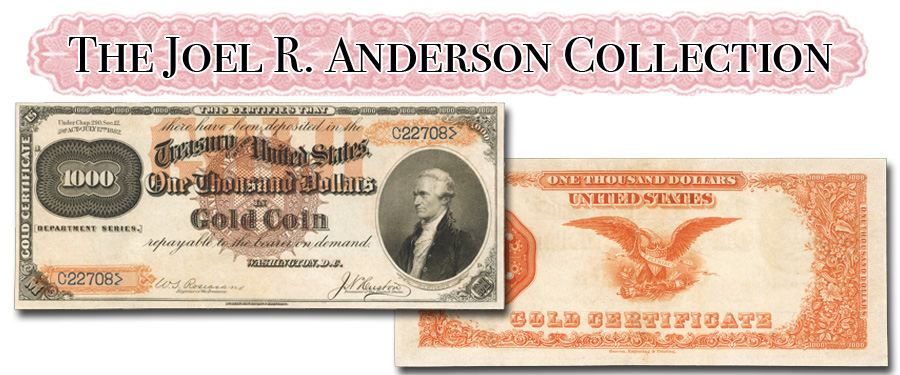
This week I feature a rarest of the rare, finest of
the fine note from the Joel R. Anderson Collection. As a class 19th century
Gold Certificates are rare. This is because all or nearly all were held
domestically and, unlike double eagles and other gold coins were not exported.
No foreign Treasury desired to hold paper money instead of metallic gold. In
contrast, double eagles were shipped abroad in quantity, and millions have been
repatriated since World War II.
That said, among Gold Certificates of the 19th
century, when they are found they are nearly always of lower denominations. The
Anderson $1000 note not only is the highest denomination in its series but is
also is the finest of just two known! The term once in a lifetime
opportunity would seem to be appropriate here, as it is for many other
notes from this collection.
Our catalog description:
Lot 2056. Friedberg 1218d (W-4618). 1882 $1,000 Gold
Certificate. PCGS Currency Extremely Fine 45.
This incredible example of a prohibitively rare 1882
$1000 Gold Certificate is the finest known for this type and seal combination
and one of only two such examples in private hands. This note all by itself in
any other major currency sale would make that sale one for the record books.
How amazing it is to have this note share the limelight with so many other
treasures!
A portrait of Alexander Hamilton
is seen at right. At center is a large brown spiked Treasury Seal with GOLD
overprinted in gold letters. A large 1000 counter is found at left. Bold blue
serial numbers are seen within gold panels at lower left and upper right. The
engraved signatures of Rosecrans and Huston are along the bottom frame line.
The back design is elaborate and executed in vibrant orange-gold. A bald eagle
with shield is at center while a large Roman numeral M counter is seen at left.
Just four examples of this catalog number are
recorded, two of which are permanently impounded in the National Numismatic
Collection and in the collection of the Federal Reserve Bank of San Francisco.
This note was the only privately held example known until another was
discovered in 2013. That example was graded Very Fine 35 by PCGS and sold for
$881,250 in a January 2014 auction.
The present piece is far more attractive with bright
paper, strikingly bold inks and only slight hints of circulation. It was first
offered as part of the Albert A. Grinnell Collection, sold by Barney Bluestone
in March 1945 where it brought $1,250. It was most recently acquired for
$1,092,500 in a June 2006 auction and has been off the market ever since.
This note hails from the Grinnell Collection, as
delineated below. Albert A. Grinnell was a partner in Grinnell Brothers, a
chain of music and related stores based in Detroit. The firm’s showrooms in
major cities featured phonographs, player pianos, radios, sheet music, and
other goods and were well known in their time. ! A good study project for an
article in Paper Money magazine would be a narrative
describing the offering of this incredible cabinet sold by Bluestone in
Syracuse, New York. This was in an era before Robert Friedberg’s
game-changing Paper Money of the United States was published
in 1953, and fewer than 10 bidders participated!
PCGS Population: 1; none finer.
From Limpert & Kemm Illustration; Barney
Bluestone’s sale of the Albert A. Grinnell Collection, March 1945, lot 566;
Currency Auctions of America’s sale of January 2000, lot 2311; Lyn Knight’s
sale of June 2006, lot 326.
Est. $600,000-$800,000





